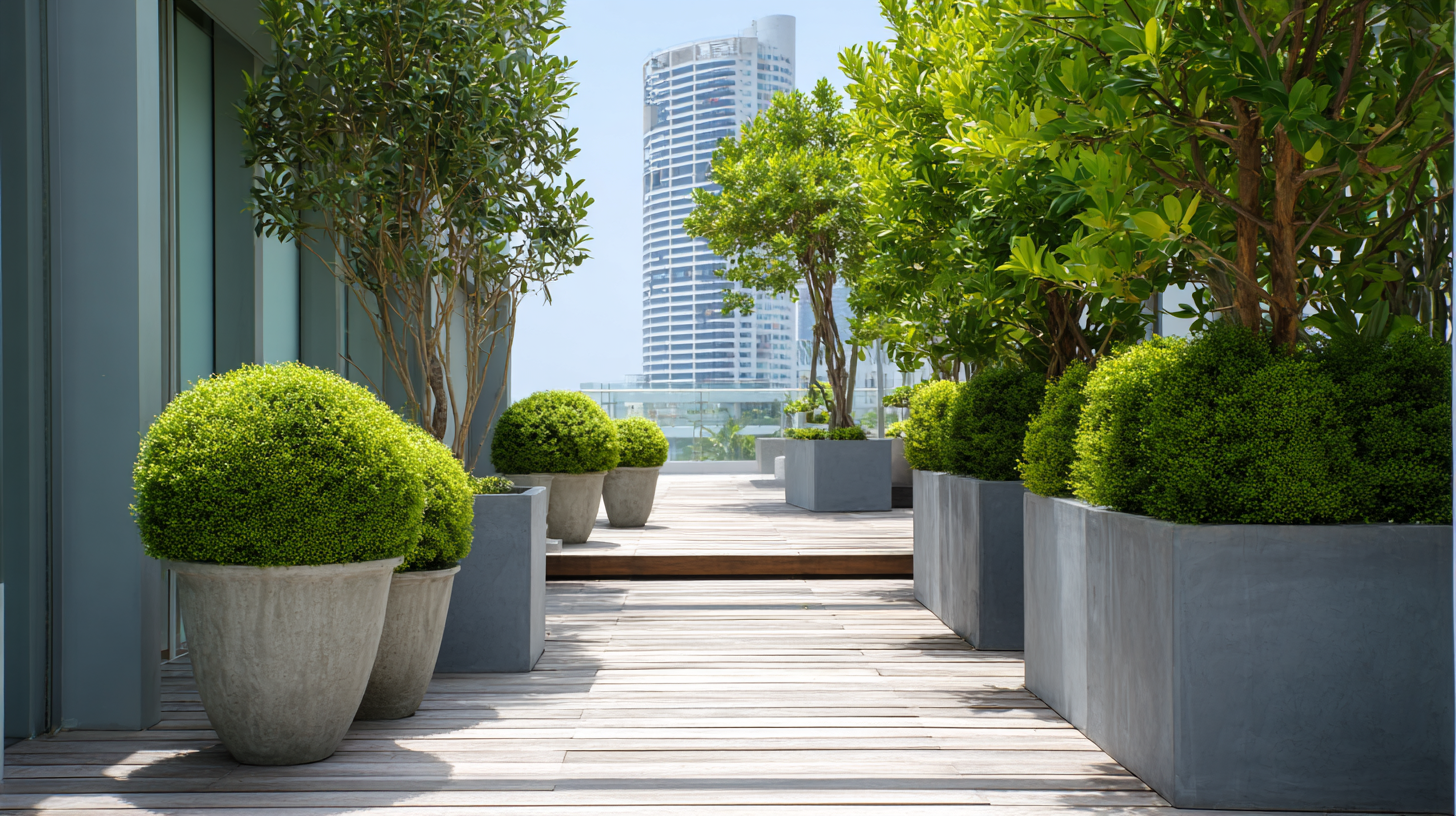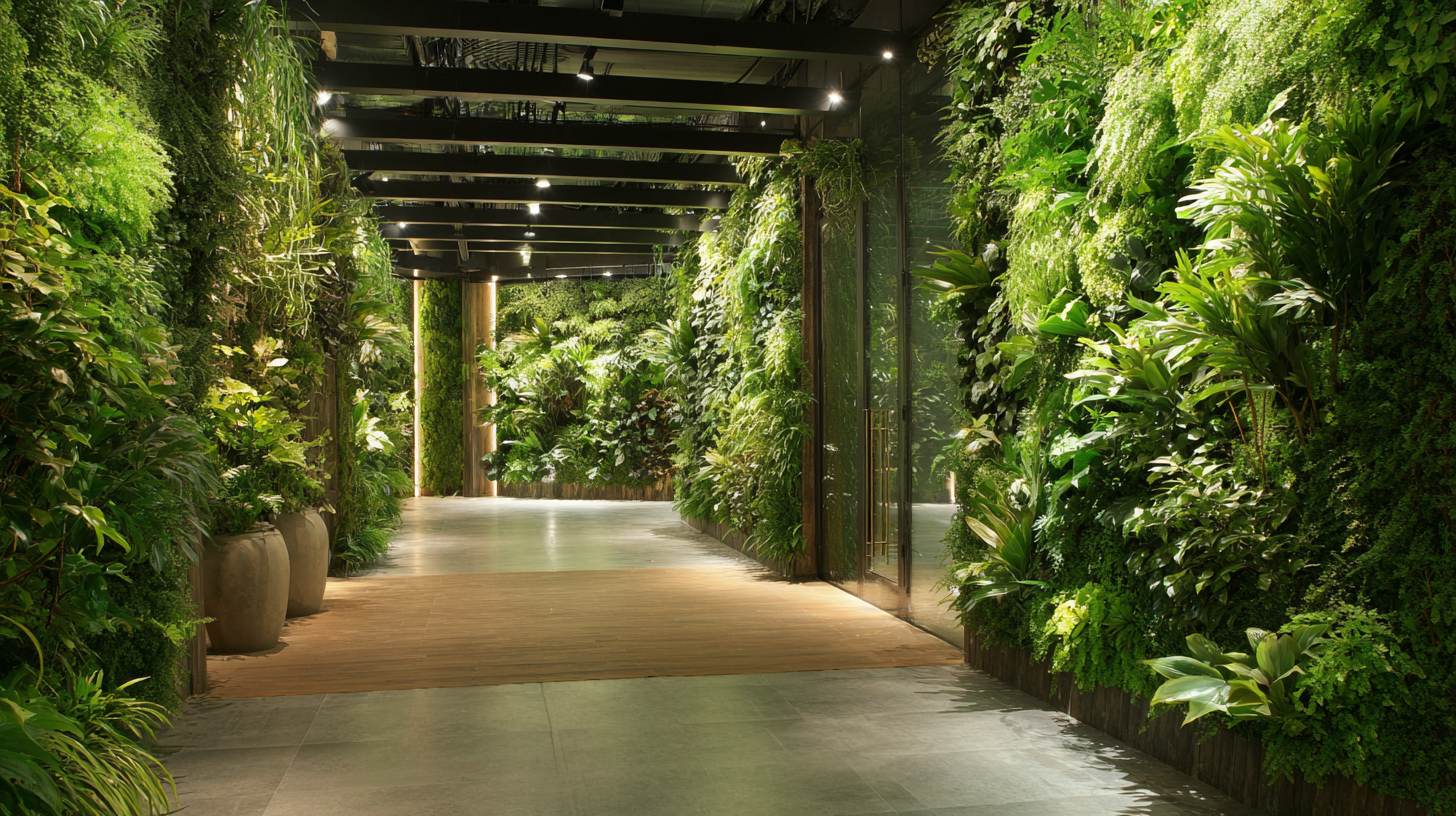
As the world becomes increasingly aware of environmental concerns, the demand for sustainable landscaping solutions has surged. A report by Grand View Research indicates that the global artificial plants market is set to reach $3.6 billion by 2025, reflecting a significant shift towards more innovative and eco-friendly outdoor aesthetics.

Artificial green plants for outside not only offer the beauty of natural foliage without the maintenance hassles but also contribute to resource conservation by reducing water use and eliminating the need for fertilizers and pesticides. As urban spaces continue to grow, incorporating these synthetic alternatives allows designers and homeowners alike to create vibrant landscapes while easing the burden on our planet's resources.
This blog will explore various strategies to effectively use artificial green plants for outside, ensuring that your outdoor spaces remain sustainable, beautiful, and environmentally friendly.
As the demand for sustainable outdoor design continues to grow, artificial green plants are emerging as a viable solution for enhancing aesthetics while minimizing environmental impact. According to a recent report by the International Society of Horticultural Science, the use of artificial plants can reduce water consumption by up to 90%, making them a practical choice for drought-prone areas. This shift not only helps conserve vital resources but also addresses the increasing challenges of maintaining natural greenery in urban settings.

Incorporating artificial green plants into outdoor spaces allows designers to create vibrant landscapes without the challenges of seasonal changes or pest management. A survey by the Green Building Council indicates that 70% of landscape architects are now considering artificial options for their projects, reflecting a notable trend towards innovative, low-maintenance design solutions. This evolution in outdoor aesthetics not only elevates visual appeal but also promotes a sustainable approach to landscaping that benefits both communities and the environment.
Tips for selecting artificial green plants include choosing high-quality, UV-resistant materials to ensure longevity and color retention. Additionally, consider the scale and proportion of plants in relation to your outdoor space to maintain a natural look. Lastly, don't hesitate to mix artificial plants with natural elements for a more dynamic and engaging landscape design.
In recent years, the trend of incorporating artificial greenery into outdoor aesthetics has gained immense popularity, especially as environmental awareness heightens. According to a 2021 report by Grand View Research, the global artificial plants market was valued at $1.34 billion and is expected to grow at a CAGR of 5.2% from 2022 to 2030. This growth is largely attributed to the desire for sustainable yet visually appealing outdoor spaces. Artificial plants offer numerous eco-friendly benefits, such as requiring no water, fertilizers, or pesticides, thereby significantly reducing environmental impact.
One of the key advantages of using artificial greenery is its versatility in design. Whether for a residential garden, commercial space, or urban development, these plants can seamlessly blend into any aesthetic framework without contributing to the depletion of natural resources. Additionally, they provide a viable solution for areas with harsh climates where real plants might struggle. A survey by the American Society of Landscape Architects found that 68% of landscape professionals are increasingly recommending artificial options for low-maintenance projects.
Tips for incorporating artificial plants into your outdoor spaces include choosing high-quality, UV-resistant materials to ensure longevity, and mixing varieties to create a realistic look. Incorporating accessories like decorative pots or planters can enhance the overall aesthetic feel, making your space inviting while being eco-conscious. Embrace this sustainable approach to elevate your outdoor environments without compromising on style.
When considering the aesthetics of outdoor spaces, both natural plants and artificial alternatives offer unique advantages and disadvantages. Natural plants bring life, color, and a sense of connection to nature, but they require regular maintenance, including watering, pruning, and pest control. They also depend on specific climate conditions and may not thrive in every environment. A major downside is their vulnerability to seasonal changes, which can diminish their appeal over time.
On the other hand, artificial green plants provide a low-maintenance solution that guarantees year-round beauty. They are perfect for homeowners looking for consistent aesthetics without the commitment of ongoing care. However, the lack of authenticity and potential environmental concerns regarding the materials used are significant factors to consider. Artificial plants can sometimes look less vibrant and may not contribute to the local ecosystem in the same way natural plants do.
**Tips:** When choosing between natural and artificial plants, consider your lifestyle and commitment level to maintenance. If you opt for artificial options, select high-quality materials that mimic the look of real plants to enhance the authenticity. For natural plants, research suitable species for your climate to ensure they thrive and maintain their beauty throughout the seasons.
This chart compares the pros of natural plants and artificial plants in terms of sustainable outdoor aesthetics. While natural plants offer a higher number of advantages, artificial plants also provide unique benefits that are worth considering for future outdoor designs.
As urban areas continue to expand, the demand for sustainable outdoor spaces has become increasingly critical. Innovative designs that incorporate artificial green plants not only offer aesthetic appeal but also provide practical solutions to various challenges. These lifelike additions can transform rooftops, balconies, and courtyards into lush oases without the need for extensive maintenance or water consumption. By utilizing high-quality synthetic materials, designers can create vibrant greenery that mimics the beauty of real plants, allowing for the seamless integration of nature into busy urban environments.

Moreover, artificial green plants can enhance the overall ambiance of outdoor spaces, creating inviting atmospheres that promote relaxation and social interaction. From vertical gardens adorned with colorful faux flowers to decorative planters filled with realistic faux shrubs, the possibilities for creative expression are endless.
Designers can experiment with various arrangements and themes, using these sustainable alternatives to evoke a sense of tranquility while maintaining the versatility required for evolving outdoor aesthetics. This shift towards incorporating artificial green plants not only aligns with sustainability goals but also enriches the outdoor experience, making it accessible and enjoyable for all.
In recent years, the integration of artificial greenery in outdoor aesthetics has gained significant momentum, aligning with the broader trends of sustainability and low-maintenance design. As homeowners and designers increasingly seek eco-friendly solutions, faux plants offer a practical alternative, transforming spaces with their hyper-realistic appearance. This shift is not merely a trend but a reflection of a growing appreciation for how artificial plants can enhance the beauty of outdoor areas while requiring minimal upkeep.
The rise of aesthetic room trends, which emphasize the importance of incorporating greenery, has also influenced how we view outdoor design. With muted color palettes becoming more popular, artificial greenery serves as a versatile element that can seamlessly complement various styles, from quiet luxury to rustic cabincore. As we head into 2024, the flourishing market for artificial grass and plants indicates that this trend will continue to shape outdoor aesthetics, making spaces not only visually appealing but also sustainable and manageable for the modern lifestyle.
| Trend | Description | Benefits | Popularity (%) |
|---|---|---|---|
| Biophilic Design | Integration of natural elements to create a sense of well-being. | Enhances mood, reduces stress, improves productivity. | 68% |
| Low Maintenance | Artificial greens require minimal upkeep compared to living plants. | Cost-effective in the long run, saves time. | 75% |
| Eco-Friendly Options | Use of recyclable materials in the creation of artificial plants. | Reduces environmental impact, sustainable choice. | 52% |
| Customization | Tailored designs to fit specific outdoor spaces and themes. | Increases aesthetic appeal, unique outdoor environments. | 60% |
| Technological Integration | Incorporating smart technology in landscaping with artificial plants. | Enhances functionality, automates maintenance tasks. | 45% |
